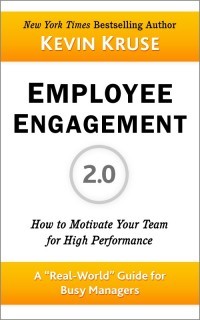
Employee Engagement 2.0
Kevin Kruse keeps employee engagement short and sweet. In Employee Engagement 2.0: How to Motivate Your Team for High Performance (A Real-World Guide for Busy Managers), which many will read in under an hour, he delivers a lot of important points.
Definition & Data
Kruse defines employee engagement as the emotional commitment an employee has to the organization and its goal.
He shares the clear evidence that engagement boosts business results, including…
- a 2009 Kenexa study in which the organizations with the highest levels of engagement earned five times the total shareholder return compared to the least engaged companies and
- a Towers Perrin study completed in 2011 that suggests engaged companies have a 6% higher net profit margin.
Beyond business results, Kruse also shares the data that indicates benefits to the employees’ personal lives. Engagement at work may lead to better health, kids that are better behaved in school, and even a better sex life.
What matters in employee engagement?
Kruse points out that the most important person in engaging an employee is their manager.
In terms of process, he sheds light on the importance of measuring employee engagement, and offers readers three options for doing so that work best for different size organizations.
I appreciated that he also made the less obvious point that sharing the results of your measurements –and what you are doing to address those results–is also key to earning engaged employees
Keys to engaging employees
According to Kruse, the key factors to success with employee engagement are:
- Abundant two-way communication
- Growth and development
- Recognition and appreciation
- Trust and confidence
Perfect? No. Effective? Absolutely.
This book is far from complete and far from perfect. Kruse doesn’t address complicated and important topics such as flow and strengths that data indicates are important and therefore I include in every employee engagement workshop I do. He doesn’t touch on compensation at all. He defines employee engagement as different than job satisfaction, then uses studies that measured job satisfaction to boost his case for the benefits of engagement.
But this book doesn’t have to be perfect to be effective. Many leaders are so busy with day-to-day demands that they don’t even know where to start with employee engagement. Kruse can tell them, in under an hour, some great places to start. I hope that anyone reading this book will then want to go deeper on how to nourish employee engagement. Please let me know if we at Happy Brain Science might be helpful.
Have you read it? If so, what did you think? If not, will you read it? Why? Please let me and other readers know in the comments.